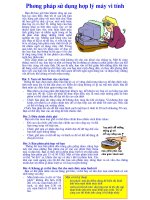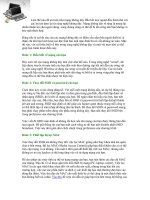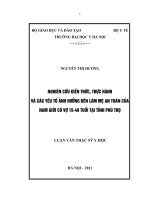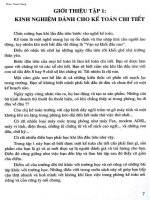LÀM VIỆC AN TOÀN TRÊN TÀU (SAFETY WORKING PRACTICE FOR TRAINEE)
Bạn đang xem bản rút gọn của tài liệu. Xem và tải ngay bản đầy đủ của tài liệu tại đây (3.6 MB, 61 trang )
Safe Working
Practices
BSM MTCAL
CODE OF SAFE WORKING PRACTISES
¾ The main concern is improving health and
safety on board.
¾ The code provides guidance for many
situations that commonly arise on board,
should be read in conjunction with the
findings of the employers asessment of
risks.
¾ Required under company procedure under
ISM CODE.
BSM MTCAL
RESPONSIBILITY-Company
¾ ENSURE safe working places and
environment.
¾ ENSURE safe plant, machinery and
equipment.
¾ ENSURE health and safety training,
instruction, supervision and
information.
¾ ENSURE supply of any necessary
protective clothing and equipment
where risks cannot be removed by other
means.
BSM MTCAL
RESPONSIBILITY-seafarer
¾
¾
¾
¾
Take reasonable care for their own health and
safety and that of others on board who may be
affected by their acts or omissions.
Co-operate with anyone else carrying out health
and safety duties-including compliance with
control measures identified during the employer’s
or company’s evaluation of risk.
REPORT any identified serious hazards or
deficiencies immediately to the appropriate
officer or other authorized person.
MAKE proper use of plant and machinery, and
treat any hazard to health or safety (such as a
dangerous substance) with due caution.
BSM MTCAL
SAFE WORKING PRACTISES
¾Painting
¾ Working Aloft
¾ Safe Mooring operations
¾ Hot Work
¾ Enclosed space entry
¾Safety signs
¾Means of access and safe movement.
¾Good housekeeping
¾Health and hygiene
BSM MTCAL
SAFE WORKING PRACTISES
Personal Protective Equipment
¾ Lifting Equipments
¾ Electrical Equipments
¾ Hydraulic/Pneumatic Equipments
¾ Portable Power Tools/Grinders)
BSM MTCAL
Please refer to Shipboard procedures/safety/sec 1/app 2
BSM MTCAL
PERSONAL PROTECTIVE EQUIPMENT
¾
¾
¾
¾
¾
¾
BSM MTCAL
Boiler Suits
Safety Shoes Steel
Toe Capped
Safety Helmets
Ear Protectors
Gloves: Welding,
cotton, leather and
rubber
Goggles For Eye
Protection
USING PPE-Good Practise
¾ Hard hats and other
appropriate PPE
worn
¾ Safe practices and
risk assessment in
operation
¾ Team management
and briefing
BSM MTCAL
BAD PRACTISE
¾ No PPE – danger
of personal injury
or worse.
¾ No risk assessment
evident.
¾ Poor management
and failure of SMS
BSM MTCAL
GALLEY PPE
¾
¾
Regulation safety shoes
and galley attire
Clean protective
clothing with non slip
shoes
¾
¾
¾
Open feet, bad hygiene
No protection from
burns or scalds if hot or
boiling water is spilt
NonNon-grip soles
BSM MTCAL
Additional Personal Protective
Equipment (PPE)
Safety Harness ----- Recommend Avoid
Using Safety Belts
¾ Welding Goggles, Visors, Aprons, Welding
Gloves
¾ Thermal Jackets
¾ Dust Masks
¾ Life Lines
BSM MTCAL
PERSONAL PROTECTIVE EQUIPMENT
¾ Portable Radios
¾
Portable Gas
Detection Alarms
¾ Chemicals Suits
¾ Fire Suits
¾ Respirators With
Correct Filters
¾ Reflective
Jackets
BSM MTCAL
HAND AND BODY PROTECTION
¾
¾
¾
¾
¾
¾
Choose the right gloves for the task –
Welding , chemical resistant,
asbestos.
Never use gloves near revolving
equipments. E.g. Lathe, Drill mach.
Do not use gloves /clothes that are
tattered or saturated with oil or
grease.
Do not wear loose/nylon clothing or
jewelry while working.
Wear long sleeved cotton overall
properly buttoned
Safety Harness to arrest falls.
BSM MTCAL
HAND AND BODY PROTECTION
¾
Suits
z
z
z
Gas/vaporGas/vapor-tight
LiquidLiquid-tight
ParticulateParticulate-tight
Partial body/limited
z
z
Aprons and sleeves
Chaps, knee pads, shin guards
Appropriate attire
z
z
Consult the Material Safety
Data Sheet (MSDS) for
appropriate type.
no loose clothing
nonnon-melting material
BSM MTCAL
HAND AND BODY PROTECTION
BSM MTCAL
HEAD PROTECTION
¾
¾
¾
¾
¾
¾
¾
Gap of 25 mm between shell and the skull of the wearer –
When crown straps adjusted properly.
Crown straps helps absorb the force of the impact.
Chin Straps to be worn always.
The helmet can withstand only as much as the neck can.
A helmet which has suffered a hard blow should be replaced
even if there is no sign of damage
Test for loss of brittleness – Replace anyway after 5 years
(EU)
Helmets should not be cleaned with solvents – use lukewarm
water.
BSM MTCAL
EAR PROTECTION
¾ High Frequency Noise most
Injurious – Slow Process
¾ Use ear protection - >80 db /
ear plugs!!
¾ Replace worn engine parts /
fans
¾ Limit time of exposure - time
of running of machine, rotating
workers etc.
BSM MTCAL
PERSONAL GAS DETECTION
¾
Multi Gas Detectors
Normally with 4 sensors for 02,
CO, H2s and LEL
¾
For Chemical/Gas Carriers Personal Gas meters with upto 14
sensors are available.
O2, CO, H2S, So2, NO, NO2, NH3,
HCN, Cl2, PH3, CO2, EO (Ethlene
Oxide), COCL2 (Phosphene)
BSM MTCAL
PERSONAL PROTECTIVE EQUIPMENT
Most Important Points!!! Always remember!!!
¾ PPE’s to be used when risks cannot be avoided/reduced to
acceptable level, by SWP
¾ PPE does not remove the hazard. It will protect only the
person wearing it, not others
¾ Sometimes PPE may in itself cause a hazard e.g. reduced
field of vision, loss of dexterity or agility etc
¾ All PPE is to be regularly checked & serviced, records
maintained
BSM MTCAL
GENERAL TIPS
9
9
9
9
Inspect PPE daily for excessive wear and tear.
Follow manufacturer’s instructions for use and
care.
Store in dry, cool locations.
Clean regularly.
BSM MTCAL
PERSONAL PROTECTIVE EQUIPMENT
Most Important Points!!! Always remember!!!
¾ Ensure PPE to be used is suitable and effective for
the task in question
¾ PPE should be checked each time before it is
worn
¾Personnel required to use the PPE to be properly
trained in its use. Records of training to maintain.
¾ Makers instructions for the PPE to strictly follow
BSM MTCAL
BSM MTCAL
LIFTING EQUIPMENT
¾ Lifting appliances to be securely anchored,
counterbalanced and supported by outriggers –
ensures stability when lifting
¾ Check safety devices of lifting devices, prior
work and as per PMS
¾ Controls to be marked permanently, with
functional & operating direction shown by
arrows
¾ Ensure ropes, chains and slings are not
knotted.
BSM MTCAL
LIFTING EQUIPMENT
¾ Ensure wire ropes used are in good condition
with test certificate and treated with suitable
lubricants.
¾ Always take of the load safely, if lifting
equipment jammed, do not work with load
hanging.
¾ Ensure SWL clearly marked on appliance,
and do not lift load more than SWL.
¾ Do not abuse any lifting equipment!!!
BSM MTCAL
LIFTING EQUIPMENT
Doors and windows well
maintained and watertight
¾ Good visibility for driver
¾ Clear markings
¾ Wires/sheaves well
greased
¾ Guardrails and ladders
in good condition
¾ Excellent access for
repair and maintenance
¾ Inspection panels
secured
¾
BSM MTCAL
LIFTING EQUIPMENT
¾
¾
¾
¾
¾
Poor visibility,
windows obscured
No markings
SWL unknown
General
maintenance
of a poor standard
Safety risk
BSM MTCAL
LIFTING EQUIPMENT MAINTENANCE
BSM MTCAL
LIFTING EQUIPMENT-SAFETIES
BSM MTCAL
ELECTRICAL EQUIPMENT
¾ Risk to electric shock very high on ships
¾ High humidity, high temperature reduce
contact resistance of body
¾ Notice for treatment of electric shock to be
displayed at high voltage
equipment/switchgear
¾ Remove fuse/open circuit breaker before
working on electrical equipment. Refer
SMD 62.
¾ Display placard for men at work
BSM MTCAL
MAIN SWITCH BOARD
¾
¾
Rubber matting –a
must at the base of all
electrical panels.
Notice for treatment
of electric shock to be
displayed at high
voltage equipment
or switchboard.
BSM MTCAL
ELECTRICAL EQUIPMENT
¾ No flammable materials to be stored near
switchboards
¾ Battery rooms to ventilate properly, as hydrogen &
oxygen is given off during charging. Battery rooms to
clearly mark “No open flame, No naked lights”
¾ Portable electric lamps/tools giving out sparks not to
be used at all.
¾ Insulation and guarding of cables to be in good
condition.
¾All extension cables, hand lamps to be inspected and to
ensure insulation not damaged.
BSM MTCAL
ELECTRICAL EQUIPMENT
Some of the portable equipment may not be for
continuous use, check the temperature of the machine. If
it is overheated give rest to the machine and use other
machine, if required. If a machine is overheated,
insulation may drop all of a sudden.
¾
¾Use guard for the portable tools where applicable.
¾Defective equipments/tools shall not be used by any
crew member until they are repaired and fit for use.
¾Any defect on the tool shall be brought to the
knowledge of C/E or E/O with immediate effect.
BSM MTCAL
INSPECTION AND MAINTENANCE
Earth pin is provided, fitted and in use
BSM MTCAL
BATTERY MAINTENANCE
Tested weekly and
recorded
¾ Electrolyte levels
maintained
¾ Located secure and
protected from the
weather
¾ PPE available for testing
and handling batteries
¾
BSM MTCAL
ELECTRICAL EQUIPMENT
¾
¾
¾
Machinery guard
securely in place
Well maintained
¾
¾
Guard missing – drive
belt exposed
Exposed machinery is a
hazard to personnel
working in the vicinity
BSM MTCAL
Hydraulic & Pneumatic equipment
¾ Only competent persons to use high pressure
hydraulic /pneumatic equipment with adequate
instructions
¾ Always follow makers instructions strictly
¾ Never do even a minor maintenance work when
equipment under pressure – release pressure
¾ Correct PPE to be worn when using high
pressure equipment
¾ Follow the PMS strictly for all high pressure
hydraulic and pneumatic equipments
BSM MTCAL
Portable hand & power tools
BSM MTCAL
Portable hand & power tools
¾ Do not issue or permit the use of unsafe hand
tools.
¾ Wrenches, pipe and socket wrenches shall not
be used when jaws are sprung to the point that
slippage occurs.
¾ Impact tools, such as drift pins, wedges, and
chisels, shall be kept free of mushroomed heads.
¾ The wooden handles of tools shall be kept free
of splinters
BSM MTCAL
Portable hand & power tools
General Safety Precautions
¾ Appropriate personal protective equipment should be
worn due to hazards that may be encountered while
using portable power tools and hand tools.
¾
¾Floors should be kept as clean and dry as possible to
prevent accidental slips with or around dangerous hand
tools.
BSM MTCAL
Portable hand & power tools
General Safety Precautions
¾ Hand tools are non-powered. They include anything
from axes to wrenches. The greatest hazards posed by
hand tools result from misuse and improper maintenance.
BSM MTCAL
Portable hand & power tools
General Safety Precautions
The following general precautions should be
observed by power tool users:
¾ Never carry a tool by the cord or hose.
¾ Never yank the cord or the hose to disconnect
it from the receptacle.
¾ Keep cords and hoses away from heat, oil, and
sharp edges.
¾ Disconnect tools when not in use, before
servicing, and when changing accessories.
BSM MTCAL
Portable hand & power tools
General Safety Precautions power tools
¾Secure work with clamps or a vise, freeing both hands
to operate the tool.
¾Avoid accidental starting. Person should not hold a
finger on the switch button while carrying a plugged-in
tool.
¾ The proper apparel should be worn.
¾All portable electric tools that are damaged shall be
removed from use and tagged
"Do Not Use."
BSM MTCAL
Portable hand & power tools
Power tool attachments
¾ A variety of accessories are available for use on or
with power tools.
¾ Caution must be exercised when selecting and using
any accessory with any power tool.
¾ Choosing the wrong accessory or using an accessory
incorrectly can result in serious
¾ Powered abrasive grinding, cutting, polishing, and wire
buffing wheels create special safety problems because
they may throw off flying fragments.
BSM MTCAL
Portable hand & power tools
Power tool attachments
¾ Before an abrasive wheel is mounted, it should
be inspected closely and sound- or ring-tested to
be sure that it is free from cracks or defects.
¾ To test, wheels should be tapped gently with a
light non-metallic instrument. If they sound
cracked or dead, they could fly apart in operation
and so must not be used. A sound and undamaged
wheel will give a clear metallic tone or "ring."
BSM MTCAL
Powered abrasive tools
¾ To prevent the wheel from cracking, the user should be
sure it fits freely on the spindle.
¾ The spindle nut must be tightened enough to hold the
wheel in place, without distorting the flange.
¾ Follow the manufacturer's recommendations. Care
must be taken to assure that the spindle wheel will not
exceed the abrasive wheel specifications.
¾ Due to the possibility of a wheel disintegrating
(exploding) during start-up, the employee should never
stand directly in front of the wheel as it accelerates to full
operating speed.
BSM MTCAL
Powered abrasive tools
¾ Portable grinding tools need to be equipped
with safety guards to protect personnel not only
from the moving wheel surface, but also from
flying fragments in case of breakage.
¾ In addition, when using a powered grinder
z Always use eye protection.
z Turn off the power when not in use.
z Never clamp a hand-held grinder in a
vise.
BSM MTCAL
Powered abrasive tools
Failure to Ring Test
• Failure to ring test
could result in a
disintegrating wheel.
• This could lead to
serious injury or
death.
Spindle guard removed for better viewing
BSM MTCAL
GOOD PRACTISE
¾
¾
¾
¾
Grinder has both
safety guards in place
Area is clean and
well lit
Spare safety goggles
easily to hand
Emergency stop
switch readily
accessible
BSM MTCAL
BAD PRACTISE
¾ Safety guards both
¾ missing
¾ Area is dirty, untidy
and poorly lit
¾ No obvious
emergency stop
button
BSM MTCAL









